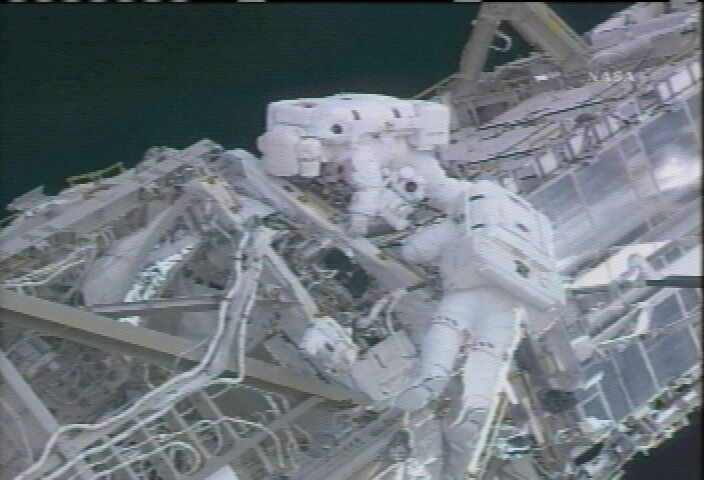Astronauts Mark 100th Station Spacewalk

Two U.S. astronauts stepped outside the International SpaceStation this morning, making the 100th spacewalk dedicated to the ongoingassembly of the orbiting outpost.
The six-hour, 56-minute extravehicular activity (EVA)performed by astronauts Peggy Whitson and Dan Tani came nine years and 11 daysafter the first station spacewalk in December 1998.
Today's excursion was devoted to inspecting two devicesrelated to the station's power generating solar arrays, both of which havemalfunctioned. Tani and Whitson were sent on the "fact-findingmission" to the Solar Alpha Rotary Joint (SARJ) and beta gimbal assembly(BGA) on the station's starboard-side in an attempt to diagnose what has causedthe earlier to shed metal filings and the latter to trip circuit breakers.
The decision by mission managers to have Whitson and Taniconduct the EVA came after space shuttle Atlantis was delayed from launching earlierthis month by a faulty low level fuel sensor system. NASA engineers began atanking test at Kennedy Space Center while Whitson and Tani were outside inorder to clear Atlantis for a January liftoff.
As the spacewalk was quickly scheduled, the Expedition 16astronauts were surprised to learn it was the 100th in station historywhen collectSPACE.com spoke with them lastweek.
"That's actually news to us about the 100th EVA,"said Tani in response to a question from collectSPACE.com. "It is kind ofmind boggling. I remember pre-ISS talking about the hundreds, or more than onehundred, EVAs that are going to be required for assembly and thinking that wasa huge mountain to climb."
"We're proud to be part of those hundred EVAs. It'svery nice to know that we're going to make that 100 mark," he concluded.
Get the Space.com Newsletter
Breaking space news, the latest updates on rocket launches, skywatching events and more!
In addition to making the 100th spacewalk, Whitson also seta record today for female total EVA time, surpassing Sunita Williams who hadset the bar at 29 hours and 17 minutes last February. Whitson became the firstwoman to command the ISS when she arrived at the station three months ago.
Including today's pair of spacewalkers, 73 astronauts andcosmonauts have worked on the ISS's exterior, including three representativesfrom the European Space Agency (France, Germany and Sweden), three from theCanadian Space Agency and an astronaut from Japan's Aerospace ExplorationAgency.
More than 624 hours -- over 26 days -- were logged by those73 explorers while performing spacewalks. Almost a third of the EVAs began outthe space shuttle's airlock; the remaining exited from the station, either fromthe US Quest or Russian Pirs airlocks. Two-thirds of the EVAs took place whilea shuttle was docked at the station; the others, like today's, during thestages between missions.
The first ISS spacewalk was made on December 7, 1998, on thesame flight that saw the docking of the first two station modules. STS-88mission specialists Jerry Ross and Jim Newman completed the 7-hour, 21-minuteEVA outside of Endeavour, connecting umbilicals on the Unity node.
The longest duration station EVA was performed by Jim Vossand Susan Helms during the 17th ISS spacewalk on March 11, 2001. For 8 hoursand 56 minutes, the two astronauts worked to configure a docking port toreceive a resupply module. The briefest EVA came three years later, after aloss of pressure in Mike Finke's oxygen tank cut short the 53rd spacewalk tojust 13 minutes.
The 100th station spacewalk was also the 289th in spacehistory. The 100th American and Russian EVAs also took place outside the ISS:the U.S. in February 2001 on the 15th ISS spacewalk; Russia, just 8 monthslater, on the 27th ISS EVA.
"That's an amazing record of resounding success,"Tani radioed as he made his way back inside near the end of today's spacewalk."A hundred space EVAs is fantastic and even though we lose a piece of tapehere and there, I think we've done incredible work and I know we couldn't havebuilt the space station without it."
"Of course we want to thank everyone involved in thisEVA," Tani continued, "but also everybody who has worked on allhundred EVAs. Everybody who makes the suits, the gloves and the procedures andthe tools... we thank them all. It's fantastic and fortunate to be the peopleout here doing the spacewalk but we know that all the hard work happens on theground."
"Oh! Thank you to whoever makes Kapton tape, too!"he was quick to add.
Click to visit collectSPACE.com for a summary of thefirst 100 station spacewalks.
- VIDEO: ISS Commander Peggy Whitson Takes Charge
- IMAGES: The STS-120 Shuttle Mission from Orbit to Earth
- SPACE.com Video Interplayer: NASA's STS-122: Columbus Sets Sail for ISS
Copyright 2007 collectSPACE.com. All rightsreserved.
Join our Space Forums to keep talking space on the latest missions, night sky and more! And if you have a news tip, correction or comment, let us know at: community@space.com.

Robert Pearlman is a space historian, journalist and the founder and editor of collectSPACE.com, a daily news publication and community devoted to space history with a particular focus on how and where space exploration intersects with pop culture. Pearlman is also a contributing writer for Space.com and co-author of "Space Stations: The Art, Science, and Reality of Working in Space” published by Smithsonian Books in 2018.In 2009, he was inducted into the U.S. Space Camp Hall of Fame in Huntsville, Alabama. In 2021, he was honored by the American Astronautical Society with the Ordway Award for Sustained Excellence in Spaceflight History. In 2023, the National Space Club Florida Committee recognized Pearlman with the Kolcum News and Communications Award for excellence in telling the space story along the Space Coast and throughout the world.









